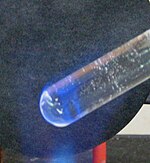Luminous test
The luminous sample is used as an extremely sensitive detection reaction for tin . It serves as a preliminary test or as evidence in a systematic separation process . The addition of zinc and hydrochloric acid creates a compound which is first cooled and which then shows tin by blue luminescence when heated .
reaction
The luminous test is a redox reaction that takes place in several stages. There are several theories for the origin of blue fluorescence:
Stannan gas
- Zinc and hydrochloric acid reacts to form nascent hydrogen and zinc chloride.
The freshly emerging, still atomic hydrogen is a powerful reducing agent . The tin (IV) or tin (II) salt contained in the sample reacts with nascent hydrogen gas to form stannane (tin hydride).
- Tin (II) ions react with nascent hydrogen to form stannane.
Tin chlorides
An alternative view describes that the luminescence is caused by tin chlorides. The zinc reduces any sparingly soluble Sn (IV) compounds in Sn (II) compounds:
Then arises tin (II) chloride , which leads by heating in the flame of the Bunsen burner to the blue lights.
The glow is based on the blue fluorescence from tin (II) ions due to thermal excitation from the burner flame.
Other sources start from tin in oxidation state 4: tin (IV) chloride (SnCl 4 ).
Disruptions
If the sample also contains a large amount of arsenic , this detection can be disrupted, since arsine can also burn with a pale blue flame. Niobium can result in false positive evidence through similar luminescent compounds.
Individual evidence
- ^ Herbert Meissner: A new reference for tin . In: Journal for Analytical Chemistry . tape 80 , no. 7-8 , July 1930, ISSN 1618-2642 , pp. 247-252 , doi : 10.1007 / bf01358047 .
- ↑ Entry on tin. In: Römpp Online . Georg Thieme Verlag, accessed on March 19, 2014.
- ^ Harry H. Binder: Lexicon of chemical elements , S. Hirzel Verlag Stuttgart 1999, ISBN 3-7776-0736-3 .
- ↑ a b c d Jander Blasius - Textbook of analytical and preparative inorganic chemistry , ISBN 978-3-7776-1388-8 , p. 499)
- ↑ G. Denk and K. Brodersen: For the detection of tin (II) - Fresenius' Journal of Analytical Chemistry 1957 doi : 10.1007 / BF00533516
Web links
- Chemgapedia.de: Detection of tin with the luminous sample






